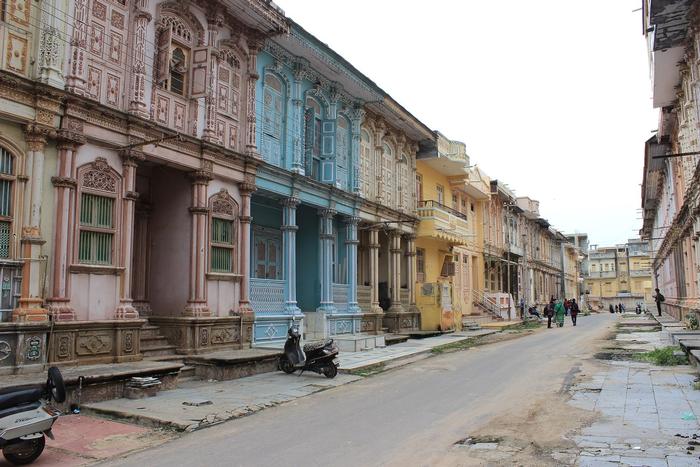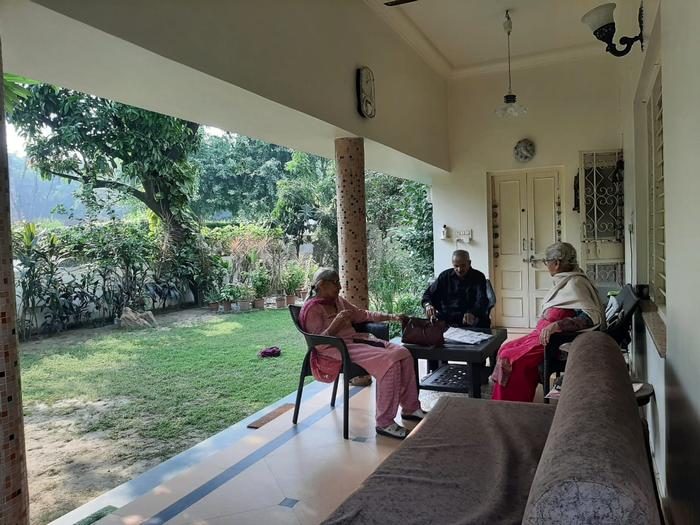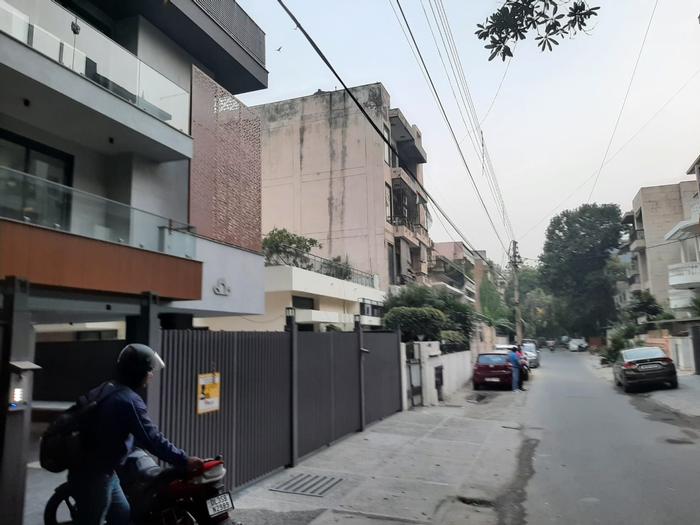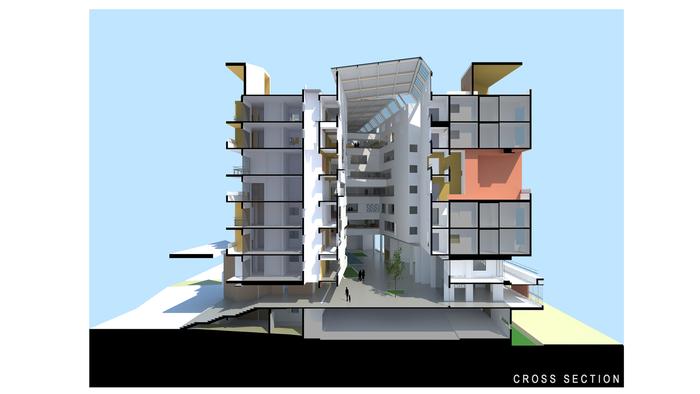[ID:4740] Environments and Ennui: The Lives of Indian ElderlyIndia “If you don't know where you've come from, you don't know where you're going.” - Maya Angelou
Ancient Indian philosophers advocated a belief system that portrayed nature as a neutral body, mediating for all creatures existing within its system. For nature to maintain its equilibrium, all systems were to retain their sovereignty with no species attempting to infringe upon the functions and roles of another. The implications were simple : over exploitation of one’s resources may lead to drastic surrender of all gains. This formulation of unitary cohesion imbued the virtues of empathy and togetherness that envisaged self-sustaining societies, adopted by the Indian culture. A codependent system is mutually symbiotic, enabling joint systems to emerge. The system formed the language, the built form and the community. Ancient Indian scripts corroborate the evidence of contiguity; compact documents with no spacings- articulating a meticulous use. Language permeated in the tightly packed Indian street-scapes and further personified the internal settings of a home- The joint family structure.
The Indian homes housed intricate joint families. The families were gerontocratic and would undergo a constant process of preceptorship, with the elderly as the nuclei of the household. Familial succession would be age based. The families were multigenerational functional models with various extensions living under the same roof. Each relationship within the household was well defined, specifying the workings of intergenerational dynamics. The relations had specific cultural and functional importance. The concept of boundaries was absent with no distinctions between oneself and the rest of the family members, resulting in the absence of any desire for individualism. The individuals would yield an identity which was ascribed to the family, instead of inscribing their own.
In the household, children displayed a strong sense of filial piety, revering the seniors. Grandparents were involved in the upbringing of the children at home. The middle generation approached the seniors with deference , considering their opinions fixed and ever binding. Marriages would be sanctioned and approved by the elders. The elders were influential Within the neighborhood; neighbors would come and seek advice from them. The senior members would gather frequently and participate in communal events and festivities with vigor. The older females from the neighborhood would indulge in inane tittle-tattle and other frivolities while conducting daily chores while the older men would discuss various topics of interests over a hookah. Caring for the geriatric needs of the seniors wasn’t perceived as an inconvenience but as a responsibility a child had to fulfill towards their parents.
In the tightly knit streetscapes, there were ample opportunities for people to fraternize, with the elders forming the largest beneficiaries. Threshold architecture spaces encapsulated various experiences that happened between “the sacred and the profane; the house and the street” (BV Doshi). The verandahs, courtyards, staircases became participatory avenues for the home and the street. The fluidity of mindless activities mixed with constant banter became the phonics of the street. Houses like havelis and bungalows with attached angans invited children and became intersections of intergenerational occupation. Houses sharing parapet walls presented engagement opportunities for people on the terrace. Such vernacular architecture provided respite from the heat and provided strategic placemaking opportunities to the residents especially the elderly. In a socially stimulated environment the elderly established their dominion circumstantially providing “eyes on street”. This constant outpour of the street and the home provided ample engagement and recreational opportunities to the elders who seldom spent time in solitude. The street in its duality worked as a conduit for transportation but also as a linear community space for congregational activities. The clustered settlements provided architectural opportunities to ameliorate manmade systems along with various conjunctions of places. The amalgamation of culture, community and architecture led to a serendipitous fabrication of the seniors within the society. This inclusion of all age groups into the spatial structure mirrored the social organization.
However, the joint family structure is being subjected to fierce restructuring that questions the foundation of the system on which it is built. The last 70 years have seen the emergence of new institutional values targeting existing ideologies and prompting family members to break free from the convention. The fall out has put the position of the seniors at stake within the social structure. The disintegration of the British Raj led to the formation of present day India and Pakistan. The partition forced families to surrender their community, resources and assets. This was the first instance of dismantling of the structure, where families had to dissociate, and acclimatize themselves to new surroundings. With the Indian visionaries trying to compete with the west, leaders like Jawaharlal Nehru sought modernism as the way forward.He did not view tradition and modernity as two ends of a spectrum , but as a healthy accord between the past and the dynamic future. However, modernism highlighted the shortcomings of the existing system. The joint family systems were extremely patriarchal and patrilineal. People started viewing them as largely authoritarian and not role based. The import of westernized learning to Indian schools, a deep sense of genders and age groups revolutionized mind sets.
Cognizant of the shortcomings of the established system, people started prioritizing individualistic desires and growth, overcoming inhibitions. Globalization and Industrialization also impacted the grip joint structures had over the system. A developing country like India couldn’t resist western influence , due to which the Indian family values are still undergoing constant restructuring. However, the elderly remained the worst impacted. Caring for the elders is a fading tradition. Yet, the kinship system has shown remarkable resistance to change, with most individuals still hesitant to isolate their parents in their old age, in spite of a deep yearning for nuclearization of homes. Indians display little to no intention of abandoning their parents. Though a progressive and developed system, it does away with the humanitarian values of looking after the members of the society. These changes left the elderly grappling to retain the importance they exerted in the olden days.
This culture paved the way for the mass production of cookie-cutter housing. Most of the vernacular construction is being foreshadowed by up and coming builder flats. The builder flats actively cut the homes from the streets, leading to the extinction of the verandah as an enterprise of social engagement. Compound walls and gates rendered the courtyard redundant. The elderly had to forfeit their spatial sovereignty and forgo their main recreational activity. The flats glorified privatized outdoor experiences and homeownership, paving way for balconies, subsequently cutting out on human expression. Such progressions that reinvented housing turned the model into industrial institutions; opportunistic and profit based. Indian homes were metaphysical centers for aggregation, which are now converted into apathy ridden mechanisms. Marwa Al-Sabouni, A Syrian architect and writer calls this the “Factory Syndrome”, where “production is an end, and people are only a means toward that end” . “The factory conceives sharp divisions: in or out”, leaving no room for liminality. The loss of such spaces highlights our defeat as a society and as vessels of cultural preservation. The present buildings are modeled in a way that the gratification of profit can potentially drive human interactions to obsolescence. Thus, the elderly being pushed further into the confines of their rooms. Within the newly established prototype housing, boundaries also solidified.
This cultural isolation is detrimental to the health of the seniors. Research has shown that isolation and loneliness can trigger various health related problems that affect cognitive and psychological functions. Social isolation may lead to a weak immune system , cause blood pressure, heart problems and sometimes even death. Seniors are susceptible to loneliness and depression from progressively worsening ennui. Loneliness triggers behavioral and biological stimuli that share an association with early death. Caregiving and volunteering prospects as gainful engagements have shown an improvement in the lives of the seniors.
According to the longitudinal Aging Study in India report, around 88% of urban elderly citizens live with children or other relatives. Presently, most of the current structures are joint in nature, with seniors fearing being moved to a senior care facility. But, with India becoming the most populous country, it is estimated that it will transition into an aging society by 2050. With the increasing influence of western culture on the Indian youths, the joint arrangements systems are projected to drop, with more and more seniors opting for senior living facilities. Thus, it is imperative to transform the hollow sense of ennui into gainful engagement of the seniors that provides various substitutes to their roles in the joint structure, and recreate the placemaking experiences they enjoyed previously.
India has multitudes of up and coming senior living programs and facilities that promote the well being of the elderly and help restore their “coveted purpose”. Seniors’ possession of wisdom and knowledge cannot be substantiated by other members of the society. The elderly are increasingly perceived as a burden, but their worldview and experiences are untapped assets that can shape societies.
Marc Freedman, an expert on longevity revolution discusses how locking the seniors away in an “all seniors paradise” is actually a practice rooted deeply in exclusion. The elderly are not meant to waste their potential but live happy fulfilling lives, surrounded by youth. He proposes a “generativity revolution”, which was developed with a belief that “I am what survives me”, passing down knowledge possessed by the seniors to the youth.
Parul Nayar, an architect from Delhi, dedicated her research to mixed use facilities for senior living arrangements due to the absence of such research in India. The study has the potential to shape design decisions of various planning authorities who are striving to establish new models for senior living facilities. Nayar develops a framework to stimulate inclusive mixed use habitat for senior facilities. The premise of her study is based on three parameters: Social engagement of seniors to establish the tactful placemaking in forming “community within a community” for intergenerational interaction along with discovering the role of the public-private interface. Employing placemaking creates a sense of in-between spaces which are inviting. Intermixing facilities can indulge seniors in volunteer work, create local job opportunities resulting in higher sociability. Secondly, “Enabling environments” working towards ensuring safety of the residents by employing various strategies like “eyes on street”, informal or mechanical surveillance, and an access control model. Interaction with nature asserts the healing effects on human cognitive abilities that lead to stress release within seniors. Thirdly, access to all that covers barrier free design. The conducted case analysis will be subjected to the attributes namely : 1. The use of placemaking, 2. Public- Private Interface, 3. Safety, 4. Role of nature and outdoor spaces. The consideration of barrier free design has been left out as the case study taken is in respect to the Indian byelaws and as specifications for elderly. Also the research does not encompass the impact of barrier free design on the Indian context but acknowledges that barrier free design should be taken as a mandate.
Both of their works are pertinent to the Indian context as Marc Freedman proposes a model of intergenerational integration and roots his philosophy of social connections in empathy that also form the essence of the Indian philosophy. Parul Nayar’s work is very contextual and provides a model that would assess presently established senior living facilities in India. Combined, their research can help understand and evolve Indian senior living facilities.
Parkside Retirement Homes, Bangalore
Park side retirement homes designed by Mindspace, completed in 2018 are a part of Brigade Orchards township located at Devanahalli.
a)Use of Creative Placemaking
The volumetric arrangement and facade play help to create a sense of location. The visitor’s attachment to the intricate play encourages them to enter. Along with the inclusion of various features like reading rooms and modest meeting spaces that offer opportunity for contact with the inhabitants, light and shadow play a crucial part in creating the connection once the user arrives.
b)The Public-Private Interface
The podium level is completely open to the public and has all the required facilities. Visitors are only permitted up until this point. The residents' leisure area is divided into a variety of uses that are dispersed throughout many floors while keeping a visual link to the open space below.
c)Safety
The entire layout revolves around a courtyard ensuring that there are always "eyes on the public spaces." To keep an eye on resident security, an entry/exit gate with a staffed guard has been installed. All communal spaces have electronic surveillance installed, and each apartment has a call point.
d)Role of Nature & Outdoor Spaces
A courtyard serves as the centerpiece of the design, with numerous water bodies translating into a relaxing experience. The existence of a skylight allows for constant daylight penetration. The strategic positioning of voids have been purposefully planned to provide break out areas in facades. These enable smaller-scale interactions to take place. The terrace has also been planned as a lively outdoor social area with seating and plants for the visual comfort of the older citizens.
Parkside retirement homes reflect an innovative planning of senior care facilities which most Indian models have been unable to achieve. This is by far a superior model of social planning unlike its counterparts which are also builder initiatives at monopolizing senior living arrangements. There are intergenerational exchange opportunities, but a lot is left to be desired from such arrangements. The project attempts to achieve the standards set by Marc Freedman’s model, but a detailed success assessment can only be evaluated in practice, not in theory.
In India, most senior citizens are acclimatized to living in joint family setups. Currently, the senior care facilities accommodate an overwhelmingly high number of senior citizens whose children are stationed abroad. But for various families that wish to live in separate accommodations from their elderly, a typical setup acknowledges one family buying multiple flats within the same complex. This way, the interaction of the families is limited and the children are able to extend support to their parents as and when required. Such an arrangement combined with healthcare assistance and fraternizing options for seniors together is a model that most families would prefer. Combining various generational groups in an intergenerational setting that promotes the continuity of the family lineage, can help advance the Indian family structure within the social fabric with only minor alterations to the present setup. Thus, to revolutionize Indian senior living arrangements, a contiguous intergenerational senior care facility is required.
References:
https://www.archdaily.com/985402/the-veranda-a-disappearing-threshold-space-in-india
changing patterns of family life in india by Pittu Laungani
Re-Imagining Ageing: The Role Of Mixed-Use Spaces In Fostering Healthy Ageing. Design For All, November 2021, Volume 16 No-11 ISSN:2582-8304
https://renovatio.zaytuna.edu/article/resisting-the-architecture-of-apathy
Longitudinal Aging Study in India (LASI), wave 1, India Report
TedTalk: How to live forever by Marc Freedman
If you would like to contact this author, please send a request to info@berkeleyprize.org. |




